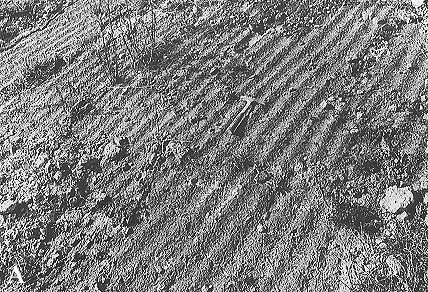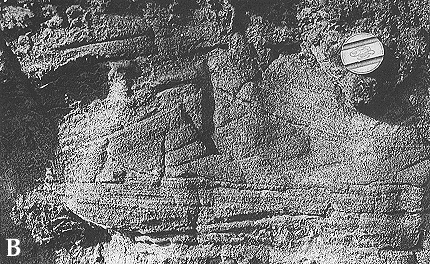

Bed forms produced by waves: oscillation ripples
Plate 45


Bed forms produced by waves: oscillation ripples
Plate 45
Plate 45 A shows the top of a thin sandstone bed in Pleistocene littoral deposits of the Marche region, Italy. The markedly linear and parallel ripples have small length and symmetrical profile. Not only have the two sides of a ripple the same inclination (see also B), but this is smaller than the angle of repose of the sand. This means that the ripples were produced by a short-period oscillatory motion, exposing alternately the two sides to fluid stress.
A modest amount of energy is sufficient to form small ripples, which implies that they record the passage of gentle waves in very shallow water or of stronger waves at a greater depth. In section view B, laminae can show both symmetrical (hut-roof) and asymmetrical (one-way dip) arrangements. They are said to be form-concordant or form-discordant, respectively, in relation with the external profile. To be precise, the term symmetrical ripple should be applied to the external shape only, and the structure as a whole should be called oscillation ripple or wave ripple (as opposed to current ripple ). One more reason for this distinction stems from the fact that wave ripples can have an asymmetrical profile. This happens when there is a difference in the power of to and fro motions a wave orbit. In their seaward movement, water particles are closer to the bottom and lose more energy by friction; after accomplishing an orbit, they do not reach their starting point. In other words, the wave orbits are not closed and a net transfer of water mass occurs landward; correspondingly, there is a net transport of sand in the same direction. It is as if the sediment were subject to a current, albeit discontinuous and incremental, and the ripples reflect it by developing a slipface on their landward side.
The sandstone of picture B is a peculiar one; it is made of fragments of volcanic glass reworked by the sea. Waves attacked a lava flow emplaced under sea level, which was fragmented by rapid quenching and transformed in a detrital mass, a hyaloclastite.
Pleistocene littoral deposits, Lipari island, Tyrrhenian Sea.
Wave ripples are environmental indicators , at least in part, i.e., concerning water depth.
We find them under a shallow-water cover (a few decimeters to meters), in littoral, lacustrine and fluvial environments. Waves are not able to form ripples below a critical depth, the so-called wave base. This depth is related to wave length and power. Longer waves have a deeper base. Waves are produced by the wind, which transmits energy to the water by fluid drag exerted at the air-water interface. Small waves generated by a breeze on a small, ephemeral pond, are sufficient to create small ripples.